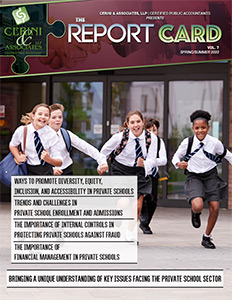Private schools play a vital role in providing quality education to students as an alternative to the public school system. However, managing the finances of a private school can often be challenging. Private schools need to balance their budgets, ensure adequate funding for school programs and activities, and maintain long-term financial stability.
Private schools traditionally rely on tuition fees, donations, and grants to cover their expenses. Financial mismanagement can lead to a shortage of funds, which can affect the quality of education and impact the school’s reputation; both of which can significantly impact ongoing enrollment. Proper financial management is crucial to the success of a private school.
Effective financial management can help private schools achieve the following:
1.) Ensure Adequate Funding:
Financial management helps private schools maintain a steady stream of revenue to fund school programs, activities, faculty, and facilities. This allows the school to provide quality education, better develop linkages with other institutions, and ensure students have a wide range of opportunities towards personal growth and development.
2.) Budget Planning:
Proper financial management requires private schools to create and maintain a budget plan that meets the needs of the school while staying within its means. This ensures that the school’s resources are used efficiently and effectively and that monitoring of fiscal operations are properly monitored throughout the year.
3.) Financial Stability:
Financial management helps private schools maintain financial stability, which is essential for the long-term success of the school. Financial stability enables private schools to weather financial challenges and continue to provide quality education to students.
Key Financial Challenges Faced by Private Schools:
Private schools face several financial challenges that can affect their financial stability. Some of these challenges include:
1.) Fluctuating Enrollments:
Enrollment is down everywhere, and private schools are not immune to these drops in enrollment. Actually, private schools often feel the decrease in students more than their public-school counterparts, especially during down economies, when discretionary funds are not as readily available. Fluctuations in enrollment, which can impact a private school’s revenue, can make it challenging for schools to maintain financial stability.
2.) Rising Costs:
Private schools face rising costs for salaries, benefits, and facilities. These costs can strain the school’s budget and impact its financial stability.
3.) Competition:
Private schools face competition from other private schools, charter schools, and public schools. This competition can make it challenging for schools to attract and retain students, impacting their revenue.
Effective Financial Management Practices for Private Schools:
Private schools can overcome these financial challenges by implementing effective financial management practices, which can include:
1.) Create an Annual Budget with Contingencies:
Private schools should create a budget that outlines their expenses and revenue. When creating the budget, they should also consider putting together certain contingency budgets in case they don’t hit their enrollment levels. The budget and contingency budgets should be approved by the school’s board prior to the start of the year, so the school already has approved cuts that can be made quickly to preserve resources if budget shortfalls occur. In addition, budget to actual analysis should take place each month to ensure that the school’s operations are in line with budgeted levels (revenue and expenses) so mid-year adjustments can be made to keep the school on-track.
2.) Create a Capital Budget:
Similar to the need to develop an operating budget, private schools should develop a 5-year rolling capital budget to understand the school’s capital needs and outflows. By understanding the capital needs of the school, the school can look into alternative funding (such as E-Rate) or can spread capital costs so that it is not all clustered in a single year or two.
3.) Increase Enrollment:
The life blood of private schools is enrollment. This is something that needs to be worked on year-round. Increased enrollment requires on-going marketing and outreach, development of scholarship/financial assistance programs, developing collaborations with other schools, etc.
4.) Endowment Development:
Many private schools already have in place endowments, the most common of which is to fund scholarships. Having a scholarship fund available to provide support to students in need can help attract more students to the school.
5.) Fundraising:
Private schools should also look to raise discretionary funds through donations, grants, and fundraising events. This can help supplement the school’s revenue and provide additional resources for programs and activities.
6.) Financial Reporting:
Private schools should maintain accurate financial records and provide regular financial reports to the school board and other stakeholders. This ensures transparency and accountability in financial management and helps the school board practice fiscal oversite and responsibility.
Proper financial management is essential for the success of private schools. Effective financial management practices can help private schools overcome financial challenges and ensure financial stability. By creating appropriate budgets (operational and capital), increasing enrollment, fundraising for operations and endowments, and maintaining accurate financial records, private schools can maintain financial stability and provide quality education to their students.

Kelly Mehr, CPA
Senior Accountant
Kelly is a senior accountant of Cerini & Associates’ audit and consulting practice. She works with nonprofit, special education and school district clients.






